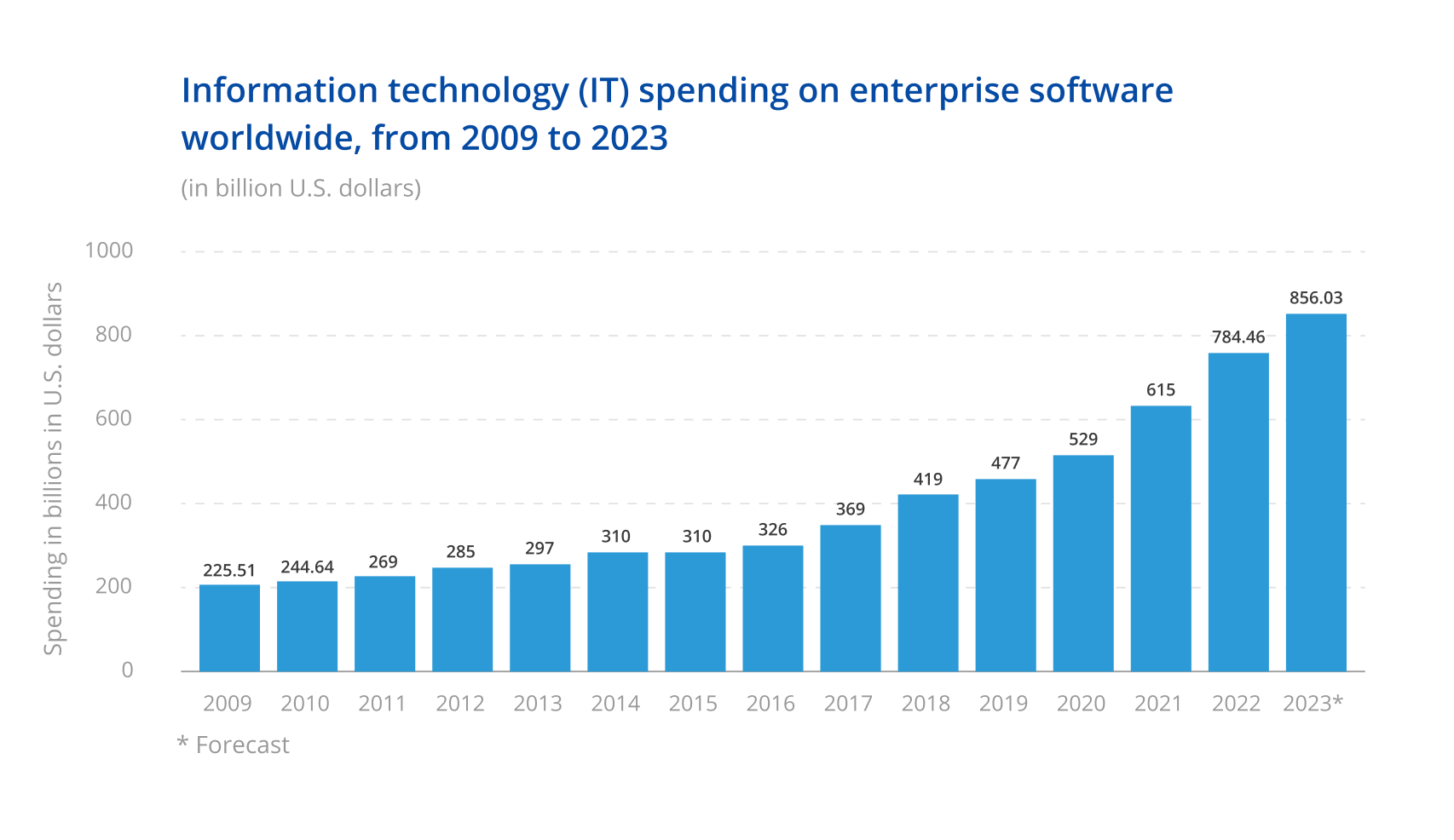In today’s competitive market, enterprise-level software development has become a very critical concern. Enterprises, owing to numerous processes and people involved, turn to a special kind of programs called enterprise software. They are harnessing the latest automation technologies to dodge operational downtimes, reduce costs, and boost productivity across the board. Meanwhile, others, who refuse to ride the automation wave, find themselves outside the competition circle and unable to keep afloat.
What Is Enterprise Software Development?
Let’s first deal with the basics. Enterprise software is a corporate product that allows to automate large-scale business processes within a company with the final objective of increasing productivity, easing the burden off some departments, or offering advanced customer service.

Some of the most common types of enterprise software include:
CRM systems
Their implementation allows you to manage user data, segment the audience, provide detailed analytics and achieve better customer retention. A specific feature of CRM software is the need to create a platform capable of withstanding high loads and properly synchronizing and updating customer data.
ERP systems
ERP software allows managing the company remotely regardless of its scale and location. One of the features of ERP deployment is building a high-load service that can simultaneously perform tasks on accounting, document management, sales and staff management, etc.
BI systems
A business intelligence platform is a solution that optimizes the monitoring, analysis and reporting processes. It calculates complex indicators, determines profitability, and evaluates risks based on the data provided. This system requires data visualization tools, the integration of CRM for sales analysis, and future-proof data security mechanisms.
DMS systems
Automated document management helps streamline signing, reporting and storing documents, while making the processes more secure. As a result, paper-based work is significantly reduced. Additionally, employees have access to any document from anywhere and at any time, which makes working communication more efficient.
The types of solutions mentioned above commonly come together. Enterprise software is often integrated with other corporate applications, so there is always a unique combination of features in line with business needs and requirements.

“Looking for a trustworthy and experienced enterprise software vendor? Let’s Talk!”
Enterprise Software Product Development Is On the Rise
The abounding number of approaches around the concept highlights the extreme significance of enterprise-scale data integration solutions. Businesses keep investing in automation, and Statista demonstrates a 7.1% growth of IT spending on enterprise software in 2022 compared to the previous year. Moreover, the growth percentage is expected to exceed 10% for 2023 numbers.

Source: statista.com
This proves how embracing automation has become a foremost concern for businesses across the globe. With the hectic market changes and their insane velocity, it is easy to go off the track in a moment. Hopefully, demand and tech advances go hand in hand, allowing companies to satisfy their needs, level up business processes, and benefit in numerous directions.
Among the key benefits, we can single out the following ones:
Employee Engagement
Automation makes communication in a team more effective while reducing the volume of repetitive, tedious tasks. It opens up an opportunity for employees to upskill and find more purpose in their work and entails high overall productivity of employees.
Process Automation
By implementing an enterprise solution, you can speed up internal processes and minimize human interference. This will in turn free up employees for more complex tasks, reduce human error, and allow for significant cost savings.
Cost Reduction
Such solutions help cut business costs by eliminating costly errors and streamlining your processes to help employees complete tasks more efficiently. Besides employee time optimization, you save money through process acceleration, more accurate data, increased mobility, etc.
Enhanced Flexibility
With enterprise software deployed, the decision-making process gets a visible upgrade as well. A business can decide on, implement and test innovative ideas with lightning speed to stay competitive in an ever-changing market.
On top of that, you get:
- A reliable IT infrastructure
- Prioritized data security
- Real-time access to data
- Improved quality control and project management
- A competitive edge in the market
- And a lot more.
Find out more enterprise software benefits and opportunities here
What Businesses Need Enterprise Software?
In short, almost any business will benefit enterprise software it:
- Small enterprises don’t have huge budges yet and will benefit from off-the-shelf enterprise software solutions.
- Medium-sized enterprises can integrate different IT systems that would exchange data ‘within a single piece of software’.
- Corporations don’t limit themselves to streamlining business processes and can build a single customized system encompassing many departments and services.
There are a number of signs that highlight the necessity of embedding enterprise software, such as:
- Multiple routine processes;
- Large data sets;
- Complex communication with clients or between employees;
- Business processes have a marked impact on each other;
- Business is sensitive to missing deadlines;
- Need for rigorous compliance with regulations and standards;
- Large volumes of tasks;
- Complicated enterprise management with a large share of manual control.
Enterprise Software Development Trends in 2023
The rapidly changing tech landscape is loaded with the latest advances and tech trends that are to form your enterprise software pillars. Here is the list of state-of-the-art technological trends that you can integrate into your software and reap substantial benefits from.
Artificial Intelligence and Machine Learning
AI and machine learning have become key drivers of business competitiveness across all industries. They can quickly take business to a completely new level, and here is how companies are benefiting from its implementation today:
- Quick analysis and response to market changes;
- Increased revenue on multiple fronts;
- Development of profitable business strategies based on the provided data and objectives;
- Eliminated human factor;
- Identifying fraud and preventing financial losses;
- Decreasing downtime and preventing failures, and more.
ChatGPT
The newly developed ChatGPT has had the transformative impact on each sphere, which turns many companies to integrating ChatGPT with the business to stay ahead of the competition. According to ResumeBuilder study results, 49% of 1,000 U.S. business leaders surveyed are currently leveraging ChatGPT in their business processes. Additionally, 93% of them are planning to expand the use of ChatGPT as it has demonstrated considerable cost savings.
ChatGPT’s adaptable conversational AI capabilities can be customized to optimize processes for businesses in any industry – let’s say, upscale customer interactions for E-commerce or personalize financial advice for FinTech. The tool’s outstanding machine learning capabilities are still being explored, which leaves us to expect more in the near future.
Cloud Computing
Cloud technologies are increasingly evolving and can offer more appealing solutions with each new year. A bigger number of companies take advantage of cloud services to have their servers located in a secure location and let the service provider take full responsibility for the equipment.
Tigera market report says that 75% of companies are focusing development on cloud-native applications as their usage has been profitable in many ways. Cloud migration relieves you of the need to buy any equipment, helps cut maintenance costs and switch focus to more complex business tasks.
Edge Computing
The concept of edge computing came about due to the exponential growth of IoT devices. They connect to the Internet to either receive data from the cloud or deliver it back to the cloud. Briefly, it allows to locally analyze the received data, right where it is produced. The technology is increasingly used in the analysis of surveillance video, car autopilots, robot control, which reduces eventual data volumes and cuts expenses.
For many companies, the use of the cloud is not feasible due to the high expenses on data channels. Here, edge computing comes into play as it can process and store data faster than in the cloud, allowing for more efficient enterprise web- and application software development.
Regulation Technologies
Regulation technologies, or RegTech, has recently been on the rise as a solution that helps businesses meet regulatory requirements faster, more easily and accurately. In addition, RegTech products help companies generate reports, ensure the identification of customers, as well as organize an effective risk management system.
As a result, deploying RegTech-based enterprise software helps you achieve greater internal alignment, enhance privacy protection and streamline compliance with the minimal risks of fines for regulatory inaccuracies.
Passwordless Authentication
In May 2022, Google officially rolled out support for passkeys, the next-generation authentication standard, as a significantly safer replacement for passwords. This authentication method allows the user to access the system without entering a password or answering a question. Instead, the user provides biometrics or possession factors (for instance, one-time passwords).
Passwordless authentication will improve data security by eliminating passwords and using more robust security techniques. More companies are integrating the technology to reduce data breach risks, avoid phishing attacks and decrease costs related to password resets and other related customer support.
Infrastructure-as-Code
Infrastructure as Code (IaC) is a key element of the today’s most efficient engineering networks in terms of infrastructure provisioning and maintenance. Instead of running a hundred different configuration files, IaC allows running a script that turns on a thousand additional machines every morning, and in the evening automatically reduces the infrastructure to an optimal scale.
With IaC deployed in your business, you configure infrastructure faster, which boosts team productivity and maintenance cost savings. On top of that, IaC standardizes infrastructure setup to any environment, minimizing errors and inaccuracies, dodges data breaches and allows for fast disaster recovery, which is invaluable for any company.
3 Steps to Build Robust Enterprise Software
Integrating enterprise software in your business, if performed right, can take your business to great heights, but when deployed wrong, it can turn your planned process into a complex one.
Let’s take a glimpse of the steps crucial to your digital success:
Gather requirements
To implement the right software, you need to determine where it is required: sales and customer base (a CRM system), warehouse accounting, corporate communication (an ERP system), or any other case.
What you do is analyze technical requirements, business needs and set a clear objective to be realized by the would-be solution. As they say, don’t gather requirements like scattered seeds; dig for them like buried treasure. So, make sure you captured all the requirements in detail and they are transparent enough to be further developed by software engineers.
Choose the right provider
Selecting a service provider who can realize your plans and meet your expectations is no less a significant task. Here, a thorough study of numerous factors is required to choose the one able to build a solution of highest quality.
A number of aspects for you to consider at this point:
- Conduct a study. Read customer reviews and find out what the provider’s delivered products are. Pay attention to those companies who have a strong qualified team and a large industry experience in addressing a variety of technical challenges for companies of all sizes.
- Do not overlook certificates. Note what certificates and awards the company holds. This will help you see their strong points, the standards they follow and meet, and other important information.
- They offer a set of solutions and flexible services. The ideal service provider is one who is always up-to-date with technology trends, IT innovation and provides a wide range of services, executes SLA guarantees and has flexible service contracts.
- Ensure project transparency. Make sure your provider generates regular reports on the completed tasks, and you can track the complete development process. This will help make adjustments if necessary and avoid possible problems.
After studying all the factors, you will be able to choose a reliable enterprise service provider that will meet all your requirements and build a product your business needs.
Track the development cycle
As soon as you found a team of software engineers and made your product requirements crystal clear, the work switches to the team’s shoulders. They develop the architecture of the product based on your business specifics and requirements. The professionals are working on the design and the functionality of your software to make it brilliant both inside and out.
When everything’s ready, testing is conducted to avoid any unexpected situations. Finally, a bug-free enterprise solution is launched and integrated with your business.
If you look for a technology partner to run your enterprise software development – you’ve come to the right place.
With GP Solutions, you can cover the whole software development life-cycle, including:
Learn more of what we’re capable of here.
Final Aspects to Consider in Enterprise Software Development
You’ve come all the road down here, and you realize the need for implementing your enterprise software. The final question – what shall I keep in mind to get the most bang for my buck and make sure my software is future-proof?
All you need is to check your software has the following features:
Scalability
An essential component of enterprise software, scalability allows for lower maintenance costs, quick scale-up, and higher agility. As a company, you’ll want to expand, and the software has to be scalable to grow along with your company.
Cybersecurity
Gartner forecasts that 45% of organizations will have experienced cyberattacks or hacking attempts by 2025. Thus, prioritizing security will help you address vulnerabilities quickly and with fewer costs
Usability
Simple navigation and an intuitive interface are crucial for enterprise products. You can multiply the importance of this aspect if your final objective is enhancing customer service.
Flexibility
Fast-paced market and society set the game rules. To survive and thrive in this rapidly changing business environment, you should always stay alert and have your software ready for new adjustments.
The Takeaway
Enterprise software development is gaining velocity and has repeatedly demonstrated the tangible benefits it offers to businesses. Remaining on the market’s competitive stage isn’t easy if you fall down on any business process. That’s why, building software for your enterprise is invaluable to close the gap, optimize processes and take your business to a completely new level.

















